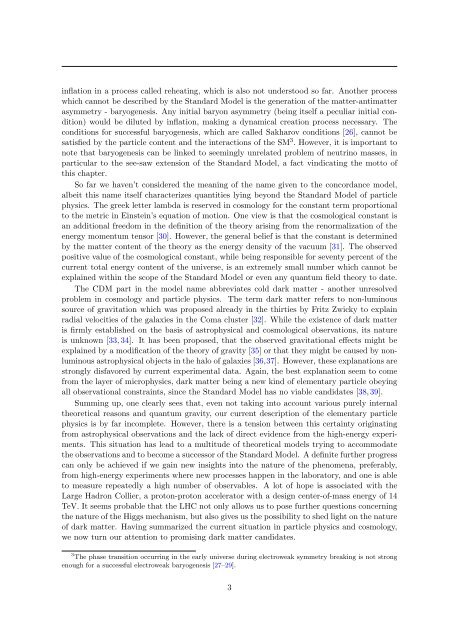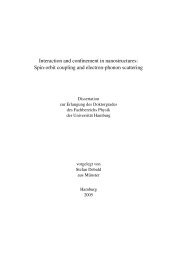Gravitinos and hidden Supersymmetry at the LHC - Universität ...
Gravitinos and hidden Supersymmetry at the LHC - Universität ...
Gravitinos and hidden Supersymmetry at the LHC - Universität ...
You also want an ePaper? Increase the reach of your titles
YUMPU automatically turns print PDFs into web optimized ePapers that Google loves.
infl<strong>at</strong>ion in a process called rehe<strong>at</strong>ing, which is also not understood so far. Ano<strong>the</strong>r process<br />
which cannot be described by <strong>the</strong> St<strong>and</strong>ard Model is <strong>the</strong> gener<strong>at</strong>ion of <strong>the</strong> m<strong>at</strong>ter-antim<strong>at</strong>ter<br />
asymmetry - baryogenesis. Any initial baryon asymmetry (being itself a peculiar initial condition)<br />
would be diluted by infl<strong>at</strong>ion, making a dynamical cre<strong>at</strong>ion process necessary. The<br />
conditions for successful baryogenesis, which are called Sakharov conditions [26], cannot be<br />
s<strong>at</strong>isfied by <strong>the</strong> particle content <strong>and</strong> <strong>the</strong> interactions of <strong>the</strong> SM 3 . However, it is important to<br />
note th<strong>at</strong> baryogenesis can be linked to seemingly unrel<strong>at</strong>ed problem of neutrino masses, in<br />
particular to <strong>the</strong> see-saw extension of <strong>the</strong> St<strong>and</strong>ard Model, a fact vindic<strong>at</strong>ing <strong>the</strong> motto of<br />
this chapter.<br />
So far we haven’t considered <strong>the</strong> meaning of <strong>the</strong> name given to <strong>the</strong> concordance model,<br />
albeit this name itself characterizes quantities lying beyond <strong>the</strong> St<strong>and</strong>ard Model of particle<br />
physics. The greek letter lambda is reserved in cosmology for <strong>the</strong> constant term proportional<br />
to <strong>the</strong> metric in Einstein’s equ<strong>at</strong>ion of motion. One view is th<strong>at</strong> <strong>the</strong> cosmological constant is<br />
an additional freedom in <strong>the</strong> definition of <strong>the</strong> <strong>the</strong>ory arising from <strong>the</strong> renormaliz<strong>at</strong>ion of <strong>the</strong><br />
energy momentum tensor [30]. However, <strong>the</strong> general belief is th<strong>at</strong> <strong>the</strong> constant is determined<br />
by <strong>the</strong> m<strong>at</strong>ter content of <strong>the</strong> <strong>the</strong>ory as <strong>the</strong> energy density of <strong>the</strong> vacuum [31]. The observed<br />
positive value of <strong>the</strong> cosmological constant, while being responsible for seventy percent of <strong>the</strong><br />
current total energy content of <strong>the</strong> universe, is an extremely small number which cannot be<br />
explained within <strong>the</strong> scope of <strong>the</strong> St<strong>and</strong>ard Model or even any quantum field <strong>the</strong>ory to d<strong>at</strong>e.<br />
The CDM part in <strong>the</strong> model name abbrevi<strong>at</strong>es cold dark m<strong>at</strong>ter - ano<strong>the</strong>r unresolved<br />
problem in cosmology <strong>and</strong> particle physics. The term dark m<strong>at</strong>ter refers to non-luminous<br />
source of gravit<strong>at</strong>ion which was proposed already in <strong>the</strong> thirties by Fritz Zwicky to explain<br />
radial velocities of <strong>the</strong> galaxies in <strong>the</strong> Coma cluster [32]. While <strong>the</strong> existence of dark m<strong>at</strong>ter<br />
is firmly established on <strong>the</strong> basis of astrophysical <strong>and</strong> cosmological observ<strong>at</strong>ions, its n<strong>at</strong>ure<br />
is unknown [33, 34]. It has been proposed, th<strong>at</strong> <strong>the</strong> observed gravit<strong>at</strong>ional effects might be<br />
explained by a modific<strong>at</strong>ion of <strong>the</strong> <strong>the</strong>ory of gravity [35] or th<strong>at</strong> <strong>the</strong>y might be caused by nonluminous<br />
astrophysical objects in <strong>the</strong> halo of galaxies [36,37]. However, <strong>the</strong>se explan<strong>at</strong>ions are<br />
strongly disfavored by current experimental d<strong>at</strong>a. Again, <strong>the</strong> best explan<strong>at</strong>ion seem to come<br />
from <strong>the</strong> layer of microphysics, dark m<strong>at</strong>ter being a new kind of elementary particle obeying<br />
all observ<strong>at</strong>ional constraints, since <strong>the</strong> St<strong>and</strong>ard Model has no viable c<strong>and</strong>id<strong>at</strong>es [38, 39].<br />
Summing up, one clearly sees th<strong>at</strong>, even not taking into account various purely internal<br />
<strong>the</strong>oretical reasons <strong>and</strong> quantum gravity, our current description of <strong>the</strong> elementary particle<br />
physics is by far incomplete. However, <strong>the</strong>re is a tension between this certainty origin<strong>at</strong>ing<br />
from astrophysical observ<strong>at</strong>ions <strong>and</strong> <strong>the</strong> lack of direct evidence from <strong>the</strong> high-energy experiments.<br />
This situ<strong>at</strong>ion has lead to a multitude of <strong>the</strong>oretical models trying to accommod<strong>at</strong>e<br />
<strong>the</strong> observ<strong>at</strong>ions <strong>and</strong> to become a successor of <strong>the</strong> St<strong>and</strong>ard Model. A definite fur<strong>the</strong>r progress<br />
can only be achieved if we gain new insights into <strong>the</strong> n<strong>at</strong>ure of <strong>the</strong> phenomena, preferably,<br />
from high-energy experiments where new processes happen in <strong>the</strong> labor<strong>at</strong>ory, <strong>and</strong> one is able<br />
to measure repe<strong>at</strong>edly a high number of observables. A lot of hope is associ<strong>at</strong>ed with <strong>the</strong><br />
Large Hadron Collier, a proton-proton acceler<strong>at</strong>or with a design center-of-mass energy of 14<br />
TeV. It seems probable th<strong>at</strong> <strong>the</strong> <strong>LHC</strong> not only allows us to pose fur<strong>the</strong>r questions concerning<br />
<strong>the</strong> n<strong>at</strong>ure of <strong>the</strong> Higgs mechanism, but also gives us <strong>the</strong> possibility to shed light on <strong>the</strong> n<strong>at</strong>ure<br />
of dark m<strong>at</strong>ter. Having summarized <strong>the</strong> current situ<strong>at</strong>ion in particle physics <strong>and</strong> cosmology,<br />
we now turn our <strong>at</strong>tention to promising dark m<strong>at</strong>ter c<strong>and</strong>id<strong>at</strong>es.<br />
3 The phase transition occurring in <strong>the</strong> early universe during electroweak symmetry breaking is not strong<br />
enough for a successful electroweak baryogenesis [27–29].<br />
3

















